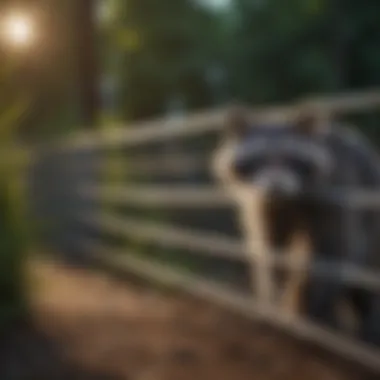Effective Strategies to Deter Raccoons in Urban Areas


Intro
Raccoons are often seen as playful nocturnal creatures. However, their behavior can create problems for homeowners. As urban sprawl continues, these animals find themselves in closer proximity to residential areas. Understanding how to deter raccoons becomes essential for maintaining home safety and protecting property. The following article will delve into various methods, barriers, and insights into raccoon habits, offering practical strategies to prevent their intrusion.
Design Inspirations
When considering ways to deter raccoons, design can play a subtle yet impactful role. Attractive landscaping might inadvertently invite raccoons to explore. Choosing designs that minimize access points can prove effective.
Trending Styles
Landscaping styles should focus on creating barriers rather than welcoming environments. Rock gardens, dense foliage, or thorny bushes can deter raccoons from wandering too close. Rather than low-maintenance grass, opt for gravel paths that restrict movement.
Color Palettes
It is vital to think about colors that do not attract raccoons. Bright, inviting colors can enhance appeal but may also draw attention from wildlife. Instead, consider earthy tones for gardens. Subtle hues blend into the natural environment and limit allure.
Maintenance and Upkeep
Effective deterrence is not a one-time effort. Regular maintenance of your outdoor space can prevent raccoons from entering your property.
Seasonal Maintenance Checklist
- Inspect Fencing: Ensure fences are tall enough (at least 4 feet) and have no gaps.
- Remove Food Sources: Store trash securely and clean up fallen fruit.
- Secure Pet Food: Bring inside any pet food that may attract raccoons.
- Check Attractants: Examine gardens for ripe fruits and vegetables that might entice raccoons.
Cleaning and Organization Tips
- Outdoor Storage: Use bins with secure lids to store pet food and gardening supplies.
- Regular Clean-Up: Weekly cleaning of patios and yards helps remove potential attractants.
- Trim Plants: Regularly trim plants to eliminate hiding spots.
"Raccoons are intelligent and adaptable; hence, prevention requires consistent effort."
By keeping these insights in mind, homeowners can establish a balance between enjoying nature and keeping unwanted raccoon visitors at bay. This guide offers a start towards managing raccoon encounters while promoting a sustainable ecosystem.
Preamble to Raccoon Behavior
Understanding raccoon behavior is crucial in devising effective strategies for prevention. Raccoons are highly adaptive creatures known for their intelligence and foraging skills. Their presence in residential areas often leads to disturbances, particularly when they rummage through garbage or vandalize gardens. By comprehending their habits, homeowners can not only mitigate unwanted intrusions but also foster a more harmonious relationship with wildlife.
Understanding Raccoon Habitats
Raccoons typically thrive in a range of environments, from urban settings to forests. They are versatile creatures, often choosing habitats near sources of food and water. Urban raccoons commonly nest in attics, sheds, and basements because these are safe from predators. Recognizing where raccoons may establish their homes can help property owners take preemptive measures. Areas with dense shrubbery or close proximity to water sources may attract raccoons.
Raccoon Feeding Patterns
Raccoons are omnivorous and resourceful foragers. Their diet includes fruits, insects, small animals, and human food, making residential areas particularly appealing. They are known to scavenge from garbage cans, bird feeders, and even pet food left outdoors. Understanding their feeding patterns highlights the importance of securing food sources to deter them. It's vital to seal garbage bins, store pet food indoors, and remove any other attractants.
Raccoon Reproductive Behavior
Raccoons typically breed once a year, with a gestation period of about 63 days. This occurs in the late winter to early spring. Female raccoons often seek out sheltered areas to give birth to their young. During this time, raccoons may become more aggressive in defending their territory, and the presence of kits can increase their foraging activity. Ensuring a raccoon-free zone during this period is essential for property security.
Understanding where raccoons live, what they eat, and how they reproduce provides vital information for effective deterrent strategies.
By familiarizing themselves with raccoon behavior, homeowners can identify risks and develop a tailored approach to manage these creatures effectively.
Identifying Raccoon Intrusions
Understanding how to identify raccoon intrusions is a vital component of effective pest management. Homeowners must recognize not only the presence of raccoons but also the signs that indicate their activity in residential areas. Timely identification allows for prompt action, decreasing the risk of damage to properties and safeguarding gardens or pets. Moreover, awareness can lead to a better understanding of raccoon habits, which can facilitate the implementation of preventive measures.
Signs of Raccoon Activity


Identifying signs of activity is crucial. Raccoons are nocturnal creatures, primarily active at night. Homeowners often notice disturbances in yards or gardens come morning. Key indicators include:
- Footprints: Raccoon tracks have distinctive claw marks and resemble small hands.
- Droppings: Their feces are often a mix of plant and animal material, roughly the size of a dog’s, and can have a strong odor.
- Damaged Property: Look for overturned trash cans, dug-up gardens, or ripped bags. These actions signify foraging behavior.
- Noises: Audible rummaging or vocalizations during nighttime can indicate raccoon presence.
Being vigilant about these signs enables homeowners to act before raccoons establish a stronghold.
Common Entry Points
Raccoons are highly adaptable and can exploit various entry points to invade properties. Understanding where these critters typically gain access can help in fortifying homes against them. Common entry points include:
- Attics and Roofs: Raccoons often seek shelter in attics. They can access these areas via broken vents or openings in the roof.
- Soffits and Eaves: Loose or damaged soffits can allow raccoons to enter through overhangs.
- Chimneys: Uncovered chimneys provide a direct route inside homes.
- Basements/Crawl Spaces: Gaps in foundation walls can invite these animals in.
- Garbage: Open or unsecured garbage bins attract raccoons due to easy food access.
To deter raccoons, it’s essential to inspect and secure these vulnerabilities. By mitigating access points, homeowners can prevent significant problems before they arise.
"Being proactive in identifying raccoon activity is the first step towards minimizing their intrusion. A keen eye can save homeowners a lot of hassle and damage."
This section outlines the fundamental aspects of recognizing raccoon intrusions. Homeowners who are informed about the signs and typical entry points can better manage their properties and ensure they remain raccoon-free.
Environmental Deterrents
Environmental deterrents play a critical role in maintaining a raccoon-free space in residential areas. These methods leverage factors found in the raccoons' environment to dissuade their presence without causing harm. The essence of using environmental deterrents lies in their passive nature; they do not require active human intervention once established. This approach minimizes the potential for conflict and fosters a more harmonious coexistence between humans and wildlife.
The key benefits of environmental deterrents include their effectiveness in creating unwanted conditions for raccoons, their low maintenance requirements, and their potential for promoting a healthier ecosystem. When implemented correctly, environmental deterrents can actively shape the behavior of raccoons in such a way that they no longer view residential areas as viable habitats or food sources.
Furthermore, these deterrents align with several ecological considerations. They support strategies that discourage raccoons while being ecologically sound, emphasizing the importance of sustainability. The focus on lighter touch solutions respects wildlife and promotes community stewardship. Using design elements that can deter raccoons can also lead to aesthetically pleasing outcomes that are beneficial for households.
Light and Sound as Deterrents
Utilizing light and sound as deterrents can effectively influence raccoon behavior. Raccoons are generally nocturnal, which means they are most active at night. Bright lights can disrupt their natural activity patterns, pushing them to seek darker, safer areas. One effective method involves motion-activated lights, which can startle raccoons when they approach your property.
In addition to light, sound can also serve as a deterrent. Devices that emit high-pitched sounds can be useful because raccoons possess acute hearing. Consistent and unexpected noises—like those from ultrasonic devices—can create discomfort for these animals, prompting them to relocate elsewhere.
"The combination of both light and sound activates a multi-sensory deterrent effect, crucial for keeping raccoons at bay."
Use of Scents and Repellents
Applying certain scents can deter raccoons due to their sensitive olfactory senses. Strong odors often indicate danger or an unwelcoming environment. For example, substances such as vinegar, hot pepper, or predator urine can discourage raccoons from venturing onto your property. These natural components can be deployed in targeted areas where raccoon activity is suspected.
Commercial repellents also provide a viable alternative. Products containing ammonia or naphthalene can create scenarios that raccoons find unpleasant. Regular application is key; otherwise, the effectiveness of the scent may diminish over time. Homeowners should ensure that any scents used are safe for surrounding wildlife and pets.
To maximize the efficacy of scented deterrents, it may help to combine them with other methods discussed previously. Using multiple deterrent strategies often leads to greater success in preventing raccoon intrusions.
Physical Barriers
Physical barriers serve as critical components in the ongoing struggle to prevent raccoon intrusions. These measures not only deter raccoons but also enhance the general security of residential properties. It is essential to establish effective barriers to keep these crafty animals at bay.
Implementing physical barriers suggests a proactive approach. Unlike temporary solutions, they offer long-term protection. The benefits include reduced risk of property damage, less likelihood of human-animal conflicts, and maintaining the overall ecological balance. A sturdy barrier can also serve as a visual deterrent. Raccoons are curious but can be cautious of unfamiliar structures, making it essential to consider the design and height of barriers.
Factors to consider include the material used, perceived height, and accessibility. It is crucial to remember that raccoons are agile creatures adept at climbing and digging. Therefore, barriers must be robust and strategically placed. A detailed assessment of potential weak points around the property should be conducted.
Fencing Solutions
Fencing represents one of the most effective physical barriers against raccoons. A well-constructed fence can effectively prevent access to yards and gardens. When considering fencing solutions, height plays an essential role. A fence should ideally be six feet tall to discourage climbing. Adding an outward curve at the top can further reduce the likelihood of a raccoon successfully scaling the barrier.
Materials matter significantly. Heavy-duty materials such as vinyl-coated wire, chain link, or wooden planks provide the necessary strength. Make sure to bury the fence at least a foot underground to deter excavation attempts. Raccoons are persistent diggers, and providing them a means to burrow underneath is a key failure point. Regular inspections of the fence should be done, ensuring no gaps exist that could allow a raccoon access.
Secure Garbage and Compost Bins
While fencing is vital, securing garbage and compost bins is equally important in deterring raccoons. These bins are often treasure troves for raccoons searching for food. Investing in raccoon-proof containers can greatly reduce the attractiveness of your property. Look for bins made from durable materials with tight-fitting lids. Ideally, the lids should be secured with locking mechanisms.


Some key strategies include:
- Storing bins in a confined area: Keeping the bins in a garage or shed makes it harder for raccoons to access them.
- Using bungee cords or weight: This adds an extra layer of security to prevent lids from being easily opened.
- Regularly cleaning bins: Ensuring bins are free from food residues deters raccoons from developing a habit.
Ultimately, securing waste is a solid deterrent that aligns with maintaining a clean and eco-friendly space. All strategies combined will increase the overall effectiveness of your raccoon prevention plan.
Behavioral Deterrents
Deterrents play a crucial role in managing raccoon populations near human habitats. Behavioral deterrents specifically aim to modify the raccoons' behavior, making residential areas less appealing. Understanding the importance of these strategies can lead to effective prevention measures. Homeowners can implement various methods that focus on removing attractions and addressing the impacts of habituation.
Removing Attractants
To successfully deter raccoons, it is essential to eliminate the resources that attract them in the first place. Raccoons are opportunistic feeders. They are drawn to easy food sources that can be found in yards, gardens, or close to homes. Here are several strategies to effectively remove attractants:
- Secure Food Sources: Store pet food, birdseed, and garden vegetables in airtight containers, preventing raccoons from accessing them.
- Proper Garbage Disposal: Use raccoon-proof trash cans. If possible, store garbage bins inside your garage until collection day.
- Compost Management: Avoid composting meats, fats, or dairy products. Consider enclosed compost bins that are difficult for raccoons to access.
- Remove Outdoor Pet Food: Feed pets indoors, or if outdoor feeding is necessary, do so at specific times to avoid leaving food out at night.
By reducing these attractants, homeowners can effectively disrupt raccoon behavior and make their properties less inviting.
Habituation and its Effects
Habituation is another significant factor in raccoon interactions with humans. Understanding this concept is essential to create effective deterrent strategies. Raccoons that become accustomed to human presence may exhibit boldness, leading to increased intrusions.
- Recognizing Habituation: Raccoons learn quickly. If they consistently find food or a safe spot, they will return, believing the area is secure.
- Impact on Deterrence: Once habituated, raccoons may ignore deterrent measures. This makes it crucial for homeowners to act quickly and consistently when deterring raccoons.
- Behavior Modification: To counteract habituation, it is essential to implement comprehensive strategies that combine behavioral and physical deterrents. This can include sudden disturbances, light, and sound to create an environment that feels unsafe for the raccoons.
"Understanding habituation helps us realize why raccoons might continue scavenging even amid efforts to deter them. A proactive approach is key to effective management."
By addressing both attractants and the concept of habituation, homeowners can protect their living spaces while fostering a balanced ecosystem that respects the presence of wildlife. This comprehensive understanding enhances the strategies that will be discussed further in the article.
Community-Based Strategies
Community-based strategies are essential in addressing the issue of raccoon populations in residential areas. This approach not only pools resources but also enhances the effectiveness of deterrence efforts. When neighborhoods work together, they can establish a unified front against raccoon intrusions. This collaboration can lead to more efficient implementation of prevention measures, sharing knowledge, and fostering a supportive environment.
Benefits of Community Coordination
- Shared Costs:
Engaging in community efforts can significantly reduce individual expenses for deterrents like fencing or secure garbage solutions. - Increased Awareness:
When a community is educated about raccoons and their behaviors, residents become more vigilant and proactive in prevention. - Collective Action:
Coordinated efforts enable communities to address problematic behavior and potential attractants more effectively, reducing raccoon populations.
Considerations
When implementing community-based strategies, several key considerations arise. Each area has unique characteristics that affect the types of deterrents that will be most effective. Additionally, engaging with local wildlife agencies for guidance can ensure practices are safe and humane.
Coordinating Neighborhood Efforts
To successfully manage raccoon populations, coordination among neighbors is crucial. Setting up a neighborhood watch program with a specific focus on wildlife management can enhance the chances of success.
A practical starting point includes organizing regular meetings. The community can discuss observations, plans, and strategies for raccoon prevention. Establishing a designated communication channel can also aid in quickly disseminating information about current raccoon activity or effective measures seen within the community.
Recommendations for Coordination:
- Form Community Groups:
Create groups where members can share information and resources about raccoon prevention. - Neighborhood Cleanup Events:
Organize community clean-up efforts to remove potential attractants such as trash or food waste that could draw raccoons. - Survey Local Areas:
Conduct surveys to identify common entry points or areas with higher raccoon presence, then devise strategies accordingly.
Educating the Community on Raccoon Issues
Education forms the cornerstone of effective raccoon deterrence. An informed community is better prepared to implement proper strategies that reduce attractants and manage wildlife behavior. This may involve workshops on raccoon biology, behavior, and effective deterrence techniques.
Some recommended actions for community education include:
- Host Informational Workshops:
Collaborate with local wildlife experts to provide accurate information on raccoon behavior and preventive measures. - Distribute Educational Materials:
Create brochures or flyers that outline best practices for securing property from raccoons. - Utilize Social Media for Awareness:
Engage community members through social media platforms to spread awareness and share updates on raccoon activity.
An informed and proactive community can significantly reduce the risks associated with raccoon intrusions.
Incorporating these strategies will foster a collaborative environment where residents can share the responsibility of maintaining a raccoon-free neighborhood. By coming together, communities can enhance the chances of successful raccoon deterrence, leading to sustainable coexistence.


Legal and Ethical Considerations
Understanding the legal and ethical aspects surrounding deterrents for raccoons is crucial for homeowners and communities. This topic encompasses respect for wildlife protection laws and the ethical implications of various deterrence methods. Balancing effective raccoon control while adhering to these laws ensures not only compliance but also promotes coexistence with local wildlife.
Understanding Wildlife Protection Laws
Wildlife protection laws vary by region, but they typically aim to safeguard native species and their habitats. Many localities classify raccoons as protected animals. Homeowners must acknowledge these regulations to avoid potential legal repercussions. Most importantly, it is illegal to harm or kill raccoons without appropriate permits.
Several key points should be considered:
- Local Regulations: Always check local wildlife laws regarding raccoons. Some areas may have specific rules concerning trapping or relocation.
- Permits: If extermination or relocation is necessary, ensure you possess the required permits.
- Reporting Issues: In cases of severe raccoon problems, homeowners should contact local wildlife authorities to understand the correct procedures.
By familiarizing oneself with these laws, homeowners can implement strategies that comply with legal standards while promoting the well-being of raccoon populations.
Ethical Deterrence Practices
Adopting ethical deterrence practices is essential for responsible raccoon management. Ethical raccoon control involves strategies that do not inflict pain or stress on the animals. It also emphasizes the larger goal of maintaining a balanced ecosystem.
Key ethical practices include:
- Non-Lethal Methods: Focus on humane deterrents such as fencing or motion-activated lights. These methods encourage raccoons to leave without causing harm.
- Education: Informing the community about responsible raccoon management can foster cooperation. Understanding raccoon behavior helps reduce conflicts.
- Environmental Enrichment: Consider creating environments that are less attractive to raccoons. This can include securing trash bins or removing food sources from yards.
"Ethical treatment of all wildlife encourages healthier ecosystems and responsible stewardship of our shared environment."
Incorporating legal and ethical considerations in deterrence strategies enhances the effectiveness of raccoon management. Homeowners are encouraged to seek solutions that balance their needs with the preservation of wildlife.
Monitoring and Adaptation
Monitoring and adaptation play crucial roles in effectively deterring raccoons. It is essential to understand that even the best strategies may not work uniformly across different situations. Regularly assessing the effectiveness of deterrent strategies is necessary for homeowners. Such evaluations help identify what works and what does not. This continual process fosters a proactive approach to managing potential raccoon invasions.
Assessing Effectiveness of Deterrence Strategies
To determine how well your deterrent methods function, developing a monitoring plan is critical. This plan should include:
- Observation: Regularly check for signs of raccoon activity, such as tracks or droppings. These could signal whether your barriers and strategies are effective.
- Documentation: Keep records of any raccoon sightings or issues faced. This data provides insight into changing patterns in raccoon behavior.
- Feedback Loop: Gather opinions from neighbors. Effective community communication can reveal if similar strategies work in their yards as well.
Utilizing motion-activated cameras can also be beneficial. These devices provide visual evidence of raccoon activity and the effectiveness of various deterrents. Over time, analysis of this footage can lead to better strategies for your particular environment.
Adapting Approaches Based on Raccoon Behavior
Adapting your methods is vital in responding to the ever-changing behavior of raccoons. Some adaptation strategies include:
- Seasonal Changes: Understand that raccoon behavior can shift with the seasons. They may be more active in warmer months when they seek food and shelter. Adjust your strategies accordingly, perhaps by tightening food security measures during these times.
- Behavioral Patterns: Monitor how raccoons interact with your environment. If they persist in finding ways around barriers, it may indicate that these methods are not sufficient. Revise the barriers or consider using more advanced deterrents.
- Education and Awareness: Stay informed about new developments in raccoon behavior and deterrent methods. Participate in local workshops or read up on proven techniques. Engaging with resources like en.wikipedia.org can provide timely updates on best practices.
Finale: Best Practices for Deterrence
Understanding how to effectively deter raccoons is crucial for homeowners and communities. These animals, while often captivating in their behavior, can cause significant disruption when they invade residential spaces. By implementing a range of strategies discussed throughout this article, individuals can greatly reduce the likelihood of unwanted raccoon encounters. This overall approach not only addresses immediate concerns but also establishes a framework for long-term success in managing wildlife interactions.
Summary of Effective Strategies
To summarize, the integration of multiple deterrent methods yields the best results. Homeowners should consider the following effective strategies:
- Physical Barriers: Installing secure fences and locking garbage cans helps prevent access to food sources.
- Environmental Deterrents: Utilizing light and sound devices can create an unwelcoming environment.
- Behavioral Changes: Removing attractants such as pet food and bird feeders when not in use minimizes raccoon interest.
These strategies must be observed consistently. Monitoring their effectiveness and adapting them as necessary can enhance deterrent outcomes over time.
Encouraging Sustainable Coexistence
Encouraging sustainable coexistence with raccoons involves understanding their role in the ecosystem. It is essential to recognize that these animals contribute to biodiversity and ecological balance. Thus, fostering an environment that satisfies human needs while respecting wildlife is paramount.
- Education: Educating community members about raccoon behavior and safe practices is vital. Programs can help promote harmony between wildlife and residents.
- Community Engagement: Joining forces with neighbors enhances the effectiveness of deterrence efforts. Coordinated action often results in higher success rates in managing raccoon populations.
- Adapting Habits: Homeowners should adapt their own habits by using raccoon-proof containers and being mindful of potential attractants.
Adopting these principles leads to a community that thrives alongside its wildlife, ensuring both safety and environmental respect. Raccoons, despite their challenges, should be viewed not merely as nuisances but as part of a complex and interwoven natural system.
By understanding the nuances of raccoon behavior and utilizing thoughtful approaches, communities can foster a secure environment for all.







